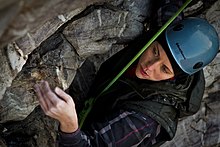User:Dmd458/Rock climbing
Terminology[edit]
Main article: Glossary of climbing terms

As climbing routes or problems increase in difficulty, climbers learn to develop skills that help them complete the climbs clean. There are several techniques for hands and feet as well as terms for motions that combine the two. For indoor gyms, route setters visualize and create routes for climbers, placing different kinds of holds in specific parts of the wall at particular angles because they intend climbers to use certain techniques.
Types of holds[edit]
Jug: A large open hold that you can fit most of your hand in. Typically in the shape of a V.[1]
sloper: A negative smooth hold, typically in the shape of a ball or half moon.[1]
pockets: A hold that has hole in it. It has just enough room for one or two fingers to sit inside of it.[2]
smearing: The act of pushing the balls or heels of your feet against the slab to create friction. When there are no foot holds available.[2]
Horn: A protruding hold that is typically smooth like a sloper. These are held by wrapping your arm, or entire palm around the hold. The more surface area you have on this hold the better.[1]
Pinch: A pinch can either be used vertically or horizontally. A pinch uses the muscle between your index finger and your thumb, and that is how wide the grip will be when using the hold. [2]
Crimp/Crimper: Crimping is a skill rock climbers use when they use just their fingertips to grab the edges and arch their fingers, using the muscles in their fingers.[2]

Arête: A sharp corner or vertical edge[1][2]
Volume: Volumes are wood or glass structures that are being supported on a climbing wall. They are giant prism features that are introduced to adapt you to a new type of hold.[1]

References[edit]
Glossary of climbing terms[1]
Learning to climb indoors[2]
- ^ a b c d e f "Glossary of climbing terms", Wikipedia, 2021-10-28, retrieved 2021-11-05
- ^ a b c d e f Hörst, Eric J. (2019). Learning to climb indoors (Third edition ed.). Guilford, Connecticut. ISBN 978-1-4930-4310-1. OCLC 1109907795.
{{cite book}}:|edition=has extra text (help)CS1 maint: location missing publisher (link)
